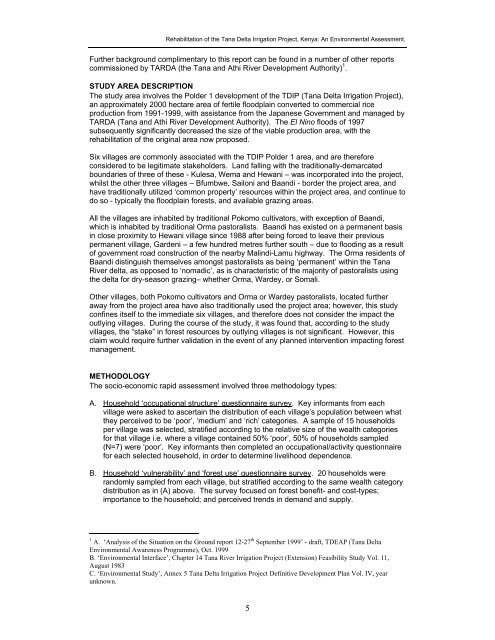Tana Delta Irrigation Project, Kenya: An Environmental Assessment
Tana Delta Irrigation Project, Kenya: An Environmental Assessment
Tana Delta Irrigation Project, Kenya: An Environmental Assessment
You also want an ePaper? Increase the reach of your titles
YUMPU automatically turns print PDFs into web optimized ePapers that Google loves.
Rehabilitation of the <strong>Tana</strong> <strong>Delta</strong> <strong>Irrigation</strong> <strong>Project</strong>, <strong>Kenya</strong>: <strong>An</strong> <strong>Environmental</strong> <strong>Assessment</strong>.<br />
Further background complimentary to this report can be found in a number of other reports<br />
commissioned by TARDA (the <strong>Tana</strong> and Athi River Development Authority) 1 .<br />
STUDY AREA DESCRIPTION<br />
The study area involves the Polder 1 development of the TDIP (<strong>Tana</strong> <strong>Delta</strong> <strong>Irrigation</strong> <strong>Project</strong>),<br />
an approximately 2000 hectare area of fertile floodplain converted to commercial rice<br />
production from 1991-1999, with assistance from the Japanese Government and managed by<br />
TARDA (<strong>Tana</strong> and Athi River Development Authority). The El Nino floods of 1997<br />
subsequently significantly decreased the size of the viable production area, with the<br />
rehabilitation of the original area now proposed.<br />
Six villages are commonly associated with the TDIP Polder 1 area, and are therefore<br />
considered to be legitimate stakeholders. Land falling with the traditionally-demarcated<br />
boundaries of three of these - Kulesa, Wema and Hewani – was incorporated into the project,<br />
whilst the other three villages – Bfumbwe, Sailoni and Baandi - border the project area, and<br />
have traditionally utilized ‘common property’ resources within the project area, and continue to<br />
do so - typically the floodplain forests, and available grazing areas.<br />
All the villages are inhabited by traditional Pokomo cultivators, with exception of Baandi,<br />
which is inhabited by traditional Orma pastoralists. Baandi has existed on a permanent basis<br />
in close proximity to Hewani village since 1988 after being forced to leave their previous<br />
permanent village, Gardeni – a few hundred metres further south – due to flooding as a result<br />
of government road construction of the nearby Malindi-Lamu highway. The Orma residents of<br />
Baandi distinguish themselves amongst pastoralists as being ‘permanent’ within the <strong>Tana</strong><br />
River delta, as opposed to ‘nomadic’, as is characteristic of the majority of pastoralists using<br />
the delta for dry-season grazing– whether Orma, Wardey, or Somali.<br />
Other villages, both Pokomo cultivators and Orma or Wardey pastoralists, located further<br />
away from the project area have also traditionally used the project area; however, this study<br />
confines itself to the immediate six villages, and therefore does not consider the impact the<br />
outlying villages. During the course of the study, it was found that, according to the study<br />
villages, the “stake” in forest resources by outlying villages is not significant. However, this<br />
claim would require further validation in the event of any planned intervention impacting forest<br />
management.<br />
METHODOLOGY<br />
The socio-economic rapid assessment involved three methodology types:<br />
A. Household ‘occupational structure’ questionnaire survey. Key informants from each<br />
village were asked to ascertain the distribution of each village’s population between what<br />
they perceived to be ‘poor’, ‘medium’ and ‘rich’ categories. A sample of 15 households<br />
per village was selected, stratified according to the relative size of the wealth categories<br />
for that village i.e. where a village contained 50% ‘poor’, 50% of households sampled<br />
(N=7) were ‘poor’. Key informants then completed an occupational/activity questionnaire<br />
for each selected household, in order to determine livelihood dependence.<br />
B. Household ‘vulnerability’ and ‘forest use’ questionnaire survey. 20 households were<br />
randomly sampled from each village, but stratified according to the same wealth category<br />
distribution as in (A) above. The survey focused on forest benefit- and cost-types;<br />
importance to the household; and perceived trends in demand and supply.<br />
1 A. ‘<strong>An</strong>alysis of the Situation on the Ground report 12-27 th September 1999’ - draft, TDEAP (<strong>Tana</strong> <strong>Delta</strong><br />
<strong>Environmental</strong> Awareness Programme), Oct. 1999<br />
B. ‘<strong>Environmental</strong> Interface’, Chapter 14 <strong>Tana</strong> River <strong>Irrigation</strong> <strong>Project</strong> (Extension) Feasibility Study Vol. 11,<br />
August 1983<br />
C. ‘<strong>Environmental</strong> Study’, <strong>An</strong>nex 5 <strong>Tana</strong> <strong>Delta</strong> <strong>Irrigation</strong> <strong>Project</strong> Definitive Development Plan Vol. IV, year<br />
unknown.<br />
5

















